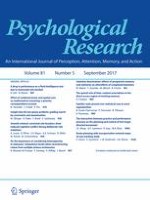31-08-2016 | Original Article
Familiar units prevail over statistical cues in word segmentation
Gepubliceerd in: Psychological Research | Uitgave 5/2017
Log in om toegang te krijgenAbstract
In language acquisition research, the prevailing position is that listeners exploit statistical cues, in particular transitional probabilities between syllables, to discover words of a language. However, other cues are also involved in word discovery. Assessing the weight learners give to these different cues leads to a better understanding of the processes underlying speech segmentation. The present study evaluated whether adult learners preferentially used known units or statistical cues for segmenting continuous speech. Before the exposure phase, participants were familiarized with part-words of a three-word artificial language. This design allowed the dissociation of the influence of statistical cues and familiar units, with statistical cues favoring word segmentation and familiar units favoring (nonoptimal) part-word segmentation. In Experiment 1, performance in a two-alternative forced choice (2AFC) task between words and part-words revealed part-word segmentation (even though part-words were less cohesive in terms of transitional probabilities and less frequent than words). By contrast, an unfamiliarized group exhibited word segmentation, as usually observed in standard conditions. Experiment 2 used a syllable-detection task to remove the likely contamination of performance by memory and strategy effects in the 2AFC task. Overall, the results suggest that familiar units overrode statistical cues, ultimately questioning the need for computation mechanisms of transitional probabilities (TPs) in natural language speech segmentation.
